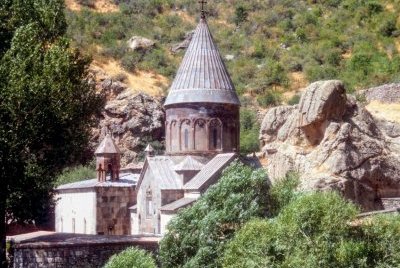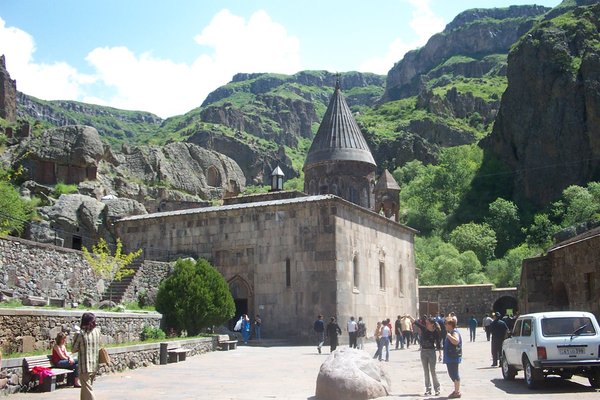Armenia
Monastery of Geghard
The Monastery of Geghard and the Upper Azat Valley are renowned for their influence on Armenian monastic architecture.
The site contains a number of churches and tombs, most of them cut into the living rock. The monastery complex was founded in the 4th century by Gregory the Illuminator at the site of a sacred spring inside a cave. The main complex, situated within a defensive wall, dates from the 13th century and holds churches, chapels, cells for monks to live in, and princely tombs. The monastery had a school and library and was an important center of learning in the Middle Ages.
Community Perspective: An atmospheric site in a delightful deep valley. The buildings stand out for their delicate carvings. Geghard is a popular day trip from Yerevan, both with tourists and pilgrims.
Site Info
Official Information
- Full Name
- Monastery of Geghard and the Upper Azat Valley (ID: 960)
- Country
- Armenia
- Status
-
Inscribed 2000
Site history
History of Monastery of Geghard
- 2000: Inscribed
- Inscribed
- Type
- Cultural
- Criteria
- ii
Links
- UNESCO
- whc.unesco.org
- Official
-
- armenia.travel — Tourism Armenia
- Related
-
- armenianheritage.org — Armenian Heritage: Geghard
- sacredsites.com — Geghard is also one of the Sacred Sites
- cilicia.com — Good introduction to the site by Cilicia.com
All Links
UNESCO.org
- whc.unesco.org — whc.unesco.org/
Official Website
- armenia.travel — Tourism Armenia
Related Resources
- armenianheritage.org — Armenian Heritage: Geghard
- sacredsites.com — Geghard is also one of the Sacred Sites
- cilicia.com — Good introduction to the site by Cilicia.com
Community Information
- Community Category
- Religious structure: Christian
Travel Information
Recent Connections
-
Perfect Inscriptions
2000 -
Muqarnas
GavitSee en.wikipedia.org
-
12 Apostles
By tradition, Saint Thaddeus (Jude) bro…
Connections of Monastery of Geghard
- Geography
- Architecture
-
-
Rock Cut Architecture
"partially carved out of the adjacent mountain" (wiki) -
Muqarnas
GavitSee en.wikipedia.org
-
Cave Temples or Churches
-
Conical roofs
-
- World Heritage Process
-
-
Inscribed on a single criterion only
ii. to exhibit an important interchange of human values, over a span of time or within a cultural area of the world, on developments in architecture or technology, monumental arts, town-planning or landscape design -
Perfect Inscriptions
2000
-
- Religion and Belief
-
-
Religious Relics
The monastery was famous because of the relics that it housed, the most celebrated the spear that wounded Christ on the Cross. Relics of the Apostles Andrew and John were donated in the 12th century (AB ev) -
12 Apostles
By tradition, Saint Thaddeus (Jude) brought the spear used to pierce Christ on the cross to Geghard. Relics from Saint Andrew and Saint John by tradition were also later brought to Geghard.See www.ancient.eu
-
Armenian Orthodox Church
"a renowned ecclesiastical and cultural centre of medieval Armenia" (OUV)
-
- Constructions
-
-
Stelae
Khachkars
-
- Timeline
-
-
Built in the 13th century
Main church built 1215 , first rock cut church by 1250
-
- Science and Technology
News
No news.
Recent Visitors
Visitors of Monastery of Geghard
- AC
- Adrian Turtschi
- Afshin Iranpour
- AK
- alex
- Alexander Barabanov
- Alexander Lehmann
- Ali Zingstra
- Andrew0181
- Anna Wludarska
- Artur Anuszewski
- Ask Gudmundsen
- Aspasia
- Atila Ege
- Bamse
- BaziFettehenne
- Bill Maurmann
- Bin
- Bram de Bruin
- Carlos Sotelo
- chiuliqi
- Cholden324
- Christian Wagner
- Christoph
- Christravelblog
- Corinne Vail
- Csaba Nováczky
- CugelVance
- Daniel Chazad
- David Berlanda
- del
- Dimitar Krastev
- Dorejd
- Dreamcatcher
- Els Slots
- Erfe91
- Erik Jelinek
- Ertai
- Eva Kisgyorgy
- Evgenii
- Fan Yibo
- Filip Murlak
- Fmaiolo@yahoo.com
- George Gdanski
- GerhardM
- Grzegorz Andruszkiewicz
- Hadrianus
- Hammeel
- HaraldOest
- Harald T.
- Harry Mitsidis
- H Beswick
- henryjiao18
- hotpickle
- Iain Jackson
- irosey
- Ivan Rucek
- Jakubmarin
- Jan Korpeg
- Janos
- Jarek Pokrzywnicki
- jballard650
- John Smaranda
- Jonas Kremer
- Jon Opol
- Juha Sjoeblom
- jxrocky
- Kevin247
- Kevin McFarland
- Knut
- Krijn
- Kristin
- krtek
- Kurt Lauer
- La Concy
- Lado Joel
- LaVale
- Liamps91
- ljowers
- Loic Pedras
- Ludvan
- Luis Filipe Gaspar
- Lukasz Palczewski
- Luke LOU
- Maciej Gil
- Mahuhe
- Maja
- Malgorzata Kopczynska
- marcel staron
- marc Rouserez
- Mariam
- Martin
- Martina Rúčková
- Marton Kemeny
- Marty
- Michael Novins
- Michael Turtle
- Mikko
- Milan Jirasek
- Miloš Tašković
- MMM
- MoPython
- nan
- NH1984
- Nick M
- Nihal Ege
- Onkrad
- Patrik_globe
- peacemaker2142
- petar
- Philipp Leu
- Pink Bunny
- Piotr Wasil
- Randi Thomsen
- Remski
- Reza
- Rick Ohm
- Risson
- rivr
- RobRos
- Rob Wilson
- Rodinia
- Roger Ourset
- Roman Bruehwiler
- Roman Raab
- Sclowitz
- Shijie ZHU
- Solivagant
- Stanimir
- Stanislaw Warwas
- Sutul
- Svein Elias
- Szucs Tamas
- Tamara Ratz
- Tarquinio_Superbo
- tedchang
- Thomas Buechler
- Thomas van der Walt
- Timothy C Easton
- tingmelvin
- tony0001
- Tony H.
- triath
- Truls Brekke
- usagi1974
- Vanessa Buechler
- Vernon Prieto
- WalGra
- Walter
- Weecheng
- Westwards
- Wojciech Fedoruk
- Wo_ko
- Xiquinho Silva
- Yevhen Ivanovych
- zfish
- Zoë Sheng
- ZZSong
Community Reviews
Show full reviews
Our half-day excursion from Yerevan led us to Garni and the Geghard Monastery. Like most visitors, we began at the reconstructed Garni Temple, which offers panoramic views of the Azat River Gorge. Continuing further up the gorge, we reached Geghard Monastery, nestled against the rugged cliffside.
Upon arrival, a short climb from the parking area brought us to the monastery gates. Here, visitors partake in a unique tradition: tossing pebbles at the cliffside. If a pebble adheres, a wish is granted. Beyond the gates lies a fortified 13th-century church, partially carved into the rock. The most captivating feature of Geghard is its intricate stone and rock carvings. Unfortunately, dim lighting during our visit hindered our full appreciation, but their craftsmanship was evident.
The site itself is compact and easily explored. Outside, the river gorge stretches, inviting further exploration. Regrettably, signposts and proper trails were lacking, limiting our hike beyond the monastery. While online images showcase breathtaking perspectives from higher vantage points, we couldn’t decipher the route.
During our summer 2023 visit, the monastery was undergoing renovations, and shrouded in scaffolding. Additionally, the site bustled with tour groups, dispelling any notion of remote isolation often associated with Geghard’s imagery online.
Getting There
Cab fares are low, making public transport or guided tours to Geghard unnecessary. An added perk awaits—a stopover at Garni, which, while not historically significant, offers picturesque photo opportunities and scenic vistas. Booking a cab via an app like Bolt proves the simplest choice.
… Keep reading 0 comments
I was at Geghard in 1978.
When we (The lady I was with and myself) walked towards one of the cave entrances we heard the sound of a flute. While entering, the echo of sounds took us in such a way that we entered into the "room" with goose pimples on our body and tears in our eyes. An experience I'll never forget.
Note: At that time there still was a problem with exercising ones religion. This lady was playing Armenian Religious Music!
Keep reading 0 comments
Geghard monastery has a great setting, amidst rocky mountains. The dark grey monastery is a popular day trip from Yerevan (often combined with the pagan-but-completely-rebuilt Garni temple), and also for school trips as I noticed. I took a guided tour here, which gets you more out of a visit (as displays in English or good guidebooks are non-existent).
Part of this monastery is hewn out of rocks (a bit similar to Lalibela). Inside, its rooms are dark, sober and cool. There are also caves left where monks prayed. Numerous khatchkars (stone crosses) are placed among the rocks.
What I liked best (besides the wonderful location) were the delicate carvings on the in-and outside of the main building. For example, the coat-of-arms relief in one of the rock churches. Also, the door in the main building is exquisite. There are a lot of Arabian influences in this work, telling another chapter of Armenia's turbulent history.
Keep reading 0 comments
All 3 of Armenia’s WHS are churches or monasteries! Apart from “ticking off” additional WHS one must ask whether there is a great deal of extra benefit to be gained from chasing all 3 since the non-expert is probably not going to discern the differences in style. Indeed you will see many more than those on the WHS (and there are several more on Armenia’s “Tentative List” too!)
We did and have no regrets at doing so. The Armenian church lies at the heart of this country’s uniqueness (together it should be stated with its alphabet/language and the sense of “difference” and “oppression” which its geographical location and history of persecution and survival have given it) and seeing its monuments and the people worshipping in them is an essential part of gaining a feel for the country.
Each of the sites is in a different setting and Geghard’s is in a delightful deep valley. Dating from the 12th century the structure is half building and half cave. Its rural location was emphasised by the sellers of bread and fruit lined up outside and the slaughtered sheep hung up for skinning nearby. It was busy – but with Armenians on pilgrimage not tourists and a quiet reverence was maintained inside. The explanations of Armenian inscriptions and of saints with strange (to us) names largely passed us by but the atmosphere of peace and tranquillity stayed with us. (Visited July 2000)
Keep reading 0 comments
